Sunday Cartoons: No Pay, No Backpay
Posted: October 1, 2023 Filed under: Climate Change, Climate change, Environment, Federal Budget, Federal Government Shutdown, Government Shutdown, House of Representatives, morning reads, open thread, Political and Editorial Cartoons, Russia-Ukraine War, Senate, the GOP, Ukraine 5 Comments
Good morning. Well they finally did it…with two hours to spare:




One thing…had the shutdown happen:

Yeah…so the janitors and cafeteria staff would never have gotten their backpay! Talk about bullshit! Doesn’t that just reek of the typical American standard.
The poor people serving the crap and cleaning up shit get double screwed in the end.




























































Trixie the kitten goes home today…so happy!
Well, that is it…I’m tired. Y’all have a safe Sunday. This is an open thread.

By the way…it is TCM in October! 🎃🎃🎃 Here is their Monthly Highlights.
Sunday Cartoons and Reads: Don’t Bother
Posted: September 24, 2023 Filed under: Climate Change, Climate change, Drag, Environment, Environmental Protection, Florida, morning reads, open thread, Political and Editorial Cartoons | Tags: New Orleans 8 Comments
Good morning…spending time on trying to get out of my mind. So today we will touch in a few things and mainly look forward to fall…or autumn.


These are some links and articles about climate…starting off with the horrific news from New Orleans.
























































































Have a safe day…this is an open thread.






Wednesday Cartoons: Sorry about the mess…
Posted: March 29, 2023 Filed under: abortion rights, children, Climate Change, Climate change, court rulings, Crimes against Children, Domestic terrorism, Florida's Mussolini, Gun Control, LGBTQIA+, mass shooting, morning reads, open thread, Political and Editorial Cartoons, Reproductive Health, Reproductive Justice, Reproductive Rights, republican craycray, Republicans NRA Blood Money, Ted "crusty" Cruz 13 Comments
Good morning, it has been a difficult couple of days…just the cartoons for today.































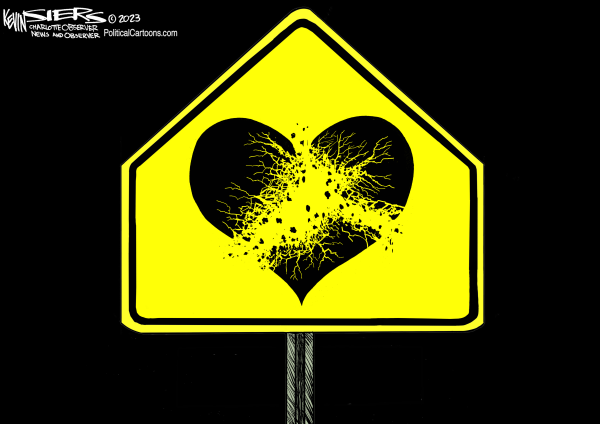



Ted Cruz seems to have the same words, literally, every time there is a mass killing…check it out:

So, what an asshole. Ditto, Ditto, Ditto!

































Next up, an interesting long read.
This next link is an important one:
Read how the local conservatives and agriculture barons are basically drowning out a largely historical black community…by refusing to do anything about the major flooding in the area of Tulare Lake.
That’s it, please be safe today. This is an open thread.
Not Just Another Monday Reads: Living through Traumaverseries
Posted: August 29, 2022 Filed under: Climate Change, Climate change, Climate/Inflation Package, corporate greed, corporatism, Environment, Environmental Protection | Tags: Hurricane Katrina anniversary 15 Comments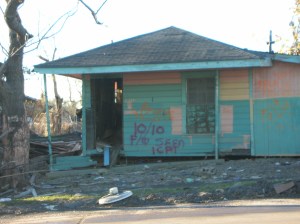 Good Day Sky Dancers!
Good Day Sky Dancers!
It’s difficult to explain how much one date could traumatize and change an entire American city but today is one of those days. 17 years ago, the levees topped after Hurricane Katrina directly hit the city. It’s still very hard for me to look at these pictures of the devastation my youngest daughter took in the Lower 9–across the canal from me–on the Thanksgiving weekend following Katrina. They were still pulling dead bodies from the debris at that time.
This top picture shows one of the few houses that didn’t collapse with its Katrina cross, indicating someone had died in that home. I watched all of this on CNN from the safety of a pink futon on the floor with my two yellow labs and Miles the Wondercat from a motel in St. Charles, LA that would later be devastated by Hurricane Rita.
My house sat high and dry on the high ground with a nearly new roof and some minor wind damage. The following six months were an experience of camping out in your own home with minimal electricity and chasing around to find working gas stations and open grocery stores. I also made a daily pilgrimage to the Red Cross station in the Quarter to pick up cleaning supplies and food. I really experienced survivor guilt too. Something I hadn’t had since I wound up being the only person known to survive the rare type of cancer I had five years before that. That was definitely not an enjoyable emotional experience either.
I’m also reminded of Hurricane Ida last year, which disrupted my life and significantly impacted my house. However, now, my insurance company wised up, gave me a $10k deductible, and basically told me I was on my own. Thankfully, I got a FEMA grant.
Teacher of the year and Katrina Survivor Chris Dier has a tremendous long thread on the federal mishaps that led to our devastation and the crony capitalism that has crippled us since then.
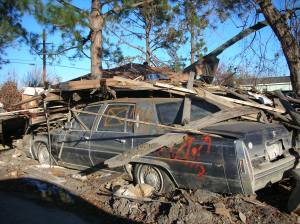 Diel lived in extremely hard-hit St. Bernard Parish, with most houses and infrastructure destroyed. He was 17 at the time. He’s chosen a series of articles to orchestrate the steps that have led us to where we are today, which is not fully recovered or whole. It’s also left us, victims, to charter schools and AirBNBs.
Diel lived in extremely hard-hit St. Bernard Parish, with most houses and infrastructure destroyed. He was 17 at the time. He’s chosen a series of articles to orchestrate the steps that have led us to where we are today, which is not fully recovered or whole. It’s also left us, victims, to charter schools and AirBNBs.
Today, I’m here to remind you that climate change is real and has already had devasting impacts all over our sweet mother earth and ecosystems and the life it supports. Failure to deal with it is a failure of global governance.
Human-driven climate change has set in motion massive ice losses in Greenland that couldn’t be halted even if the world stopped emitting greenhouse gases today, according to a new study published Monday.
The findings in Nature Climate Change project that it is now inevitable that 3.3 percent of the Greenland ice sheet will melt — equal to 110 trilliontons of ice,the researchers said. That will trigger nearly a foot of global sea-level rise.
The predictions are more dire than other forecasts, though they use different assumptions.While the study did not specify a time frame for the melting and sea-level rise, the authors suggestedmuch of it can play out between now and the year 2100.
“The point is, we need to plan for that ice as if it weren’t on the ice sheet in the near future, within a century or so,” William Colgan, a study co-author who studies the ice sheet from its surfacewith his colleaguesat the Geological Survey of Denmark and Greenland, said in a video interview.
https://twitter.com/JacksonVoss/status/1564266109058023425
This is the link to the above Twitter and is from Southerly Magazine. Minorities and the poor are the ones suffering the most from the impact of climate change. “ ‘They want us gone’: Black Louisianans fight to rebuild a year after Ida. Residents of Ironton and West Point a la Hache are still pushing federal and state agencies to help them make their communities safer before the next storm.”
A year after Hurricane Ida brought eight to 15 feet of floodwater to Plaquemines Parish—a coastal parish in Southeast Louisiana—historic Black communities Ironton and West Point a la Hache are still fighting for a just recovery. Slow-moving action from federal agencies like HUD and FEMA, a massive shortage in affordable housing, and inadequate flood protection have left residents facing a difficult decision: leave behind neighbors, traditional lifeways, and ancestral lands to migrate in search of housing, or fight to rebuild, elevate homes and make the coast more resilient to intense storms.
I’ve been working as an organizer in Plaquemines Parish since 2020, starting with a successful campaign to stop an oil terminal from excavating a cemetery where enslaved people were laid to rest. I continue to support residents in their efforts to rebuild after Ida and advocate for stronger flood protection. Recently, I spoke with several residents to hear about their experience with recovery from the storm. A year since Ida’s landfall, nearly all of my friends in Plaquemines Parish have yet to return home.
Many residents are still living in temporary housing. FEMA has long been criticized for its inability to address emergency housing needs in a timely manner. In Southwest Louisiana, some families whose homes were destroyed in Hurricane Laura waited 10 months for FEMA to issue temporary trailers. After the 2021 hurricane season, Louisiana set up a new emergency housing program called the Ida Sheltering Program to issue travel trailers more quickly, and the state has housed nearly 12,000 residents through this program. But it’s unclear what other housing options are available to them. Louisiana faced a severe shortage of affordable housing before the hurricane.
Ironton residents have hung signs throughout their community to let Plaquemines Parish know they intend to come back and rebuild.
 The Biden Administration and Democratic Congress have made meager but credible steps toward alleviating Climate Change devastation. But will it be enough for Democrats to hold on and improve their position in Congress to continue the fight?
The Biden Administration and Democratic Congress have made meager but credible steps toward alleviating Climate Change devastation. But will it be enough for Democrats to hold on and improve their position in Congress to continue the fight?
In Nevada, the intense heat brings drought and different problems due to climate change. This is from The Washington Post. “In fast-warming Nevada, climate bill may not lift Democrats. Sen. Catherine Cortez Masto (D-Nev.) has campaigned on the biggest climate bill in U.S. history. But her pitch may not resonate with voters who are more worried about the rising cost of living.” Is it really the short-term economic woes that will draw voters?
About a week after President Biden signed into law the largest climate bill in U.S. history, Sen. Catherine Cortez Masto (D-Nev.) laid out to voters here how she helped get $4 billion in the bill to combat the acute drought now punishing the American West. Outside the air-conditioned offices of the Las Vegas Valley Water District where she spoke, the temperature stood at 93 degrees — on its way to an oppressive 106 later that day.
“As you all know, the western U.S. continues to face a historic drought, and we need to do all we can to combat it,” Cortez Masto said Monday, standing before a photo showing the nation’s largest reservoir, Lake Mead, at record lows. “That’s why I have been championing measures to help Southern Nevada further conserve, recycle and reduce water use.”
Cortez Masto — one of the most vulnerable Democratic senators up for reelection this year — has spent recent weeks courting Nevada voters who want leaders in Washington to prioritize the climate crisis. Yet climate change has rarely decided the outcome in congressional races, even in Las Vegas, the nation’s second-fastest warming city in a region experiencing the most extreme drought in 1,200 years.
Voters across the country have consistently ranked the economy and health care as a higher priority than global warming. And if Democrats cannot successfully sell their environmental agenda in Nevada, which has seen a cascade of climate disasters this summer, it’s unclear whether climate concerns will ever become paramount in key national races.

Warning of doom: ‘Hunger stones’ surface in drought-stricken waters
Any part of the country served by the waters of the Colorado River is bound to be uninhabitable sooner than later. The Deserts and Coasts of our country are rapidly becoming places where life cannot be sustained.
The generous monsoon season along the Upper Basin of the Colorado River has been a relief to those who remember recent summers suffocated by wildfire smoke in the American West. But according to Brad Udall, senior water and climate research scientist at the Colorado Water Institute and director of the Western Water Assessment at Colorado State University, the relief we’re feeling now is a sign of bigger problems for years to come.
“Next year’s runoff will be really interesting to see what happens, it will be a test of this theory of depleted soil moisture,” Udall told a packed room at the Betty Ford Alpine Gardens Education Center on Aug. 19. The theory he referenced examines how the recent precipitation affects the trending drought conditions, drying reservoirs and the lowering state of the Colorado River, which is the primary source of water for over 40 million people spread across seven Western states, over thirty Native American tribes and into Mexico.
Udall’s relationship with the Colorado River goes deeper than just the focus of his studies. He grew up along its banks and worked as a river guide in his earlier years. He also comes from a long lineage of family members who have been influential in the river’s management for more than a century. His father, former congressman Mo Udall, fought to channel river water to Arizona. His uncle, Stewart Udall, was the former Secretary of the Interior who opened the Glen Canyon Dam. And his great great grandfather, John D. Lee, established Lees Ferry in Arizona. “Udalls are, in fact, Lees,” he told the crowd.
With a litany of charts, peer-reviewed studies and side-by-side chronological photographs of depleting reservoirs, Udall’s presentation, titled, “Colorado River Crisis: A Collision of 19th Century Water Law, 20tth Century Infrastructure and a 21st Century Population Growth and Climate Change,” broke down the intricacies of the compact that draws the water rights between these states, while establishing the environmental agitators that have formed, and grown, since the compact was agreed upon in 1922.
Merriam-Webster defines “drought” as “a period of dryness especially when prolonged.” According to Udall, we are beyond treating the Colorado River crisis as something that will soon pass, or ever will.
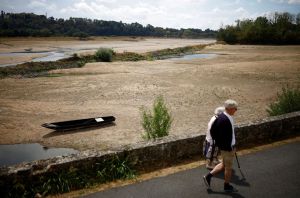
People walk near a bank of the Loire River as historical drought hits France, in Loireauxence, France, August 16, 2022. REUTERS/Stephane Mahe
From Daily Sabah: “Warning of doom: ‘Hunger stones’ surface in drought-stricken waters.”
Carvings in boulders that were used to record historic droughts are resurfacing in waterways across drought-stricken Europe.
Ancient ominous warnings carved on usually submerged boulders along the Elbe River had for centuries driven fear into the hearts of Czechs, but their reappearance during this year’s drought is just a reminder of how tough people had it.
The stones can only be seen above the water surface during droughts and are used to presage bad harvests, interrupted river navigation and consequent famine. Now, the messages appear weeks after weather and crop forecasts.
Such a stone on the banks of the Elbe River, which starts in the Czech Republic, and ends in Germany dates back to 1616. The boulder was inscribed with “Wenn du mich seest, dann weine” – “If you see me, then weep,” according to a Google translation.
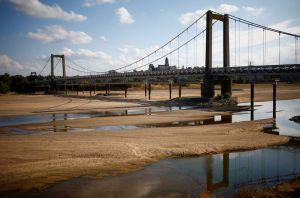
A view shows a branch of the Loire River as an historical drought hits France, in Loireauxence, France, August 16, 2022. REUTERS/Stephane Mahe
From Reuters: “France’s river Loire sets new lows as drought dries up its tributaries.”
France’s river Loire, famous for the hundreds of castles gracing its shores, is a shallow river at the best of times, but this year even its flat-bottom tourist barges can barely navigate waters greatly reduced by a record drought.
Even some 100 kilometers from where the Loire empties into the Atlantic Ocean, sand banks now stretch as far as the eye can see, large islands connect to the shore and in places people can practically walk from one side of the river to the other.
This is not normal. The nations in Africa address Climate Change today in a conference in Gabon.
One last thing from Louisiana!
Okay, maybe two! What’s on your reading and blogging list today? It’s okay to put other topics up. Our threads are always open!
Sunday Reads: Terrorwatts
Posted: February 28, 2021 Filed under: Climate Change, Democratic Politics, Domestic terrorism, energy, Environment, morning reads, open thread, Political and Editorial Cartoons, Republican politics, the GOP | Tags: CPAC 14 Comments
Good morning…








This next link truly is mind boggling…
I don’t understand this Bitcoin shit…
The cryptocurrency’s value has dipped recently after passing a high of $50,000 but the energy used to create it has continued to soar during its epic rise, climbing to the equivalent to the annual carbon footprint of Argentina, according to Cambridge Bitcoin Electricity Consumption Index, a tool from researchers at Cambridge University that measures the currency’s energy use.
…
Bitcoin mining – the process in which a bitcoin is awarded to a computer that solves a complex series of algorithms – is a deeply energy-intensive process.
“Mining” bitcoin involves solving complex math problems in order to create new bitcoins. Miners are rewarded in bitcoin.
Earlier in bitcoin’s relatively short history – the currency was created in 2009 – one could mine bitcoin on an average computer. But the way bitcoin mining has been set up by its creator (or creators – no one really knows for sure who created it) is that there is a finite number of bitcoins that can be mined: 21m. The more bitcoin that is mined, the harder the algorithms that must be solved to get a bitcoin become.
Now that over 18.5m bitcoin have been mined, the average computer can no longer mine bitcoins. Instead, mining now requires special computer equipment that can handle the intense processing power needed to get bitcoin today. And, of course, these special computers need a lot of electricity to run.
The amount of electricity used to mine bitcoin “has historically been more than [electricity used by] entire countries, like Ireland”, said Benjamin Jones, a professor of economics at the University of New Mexico who has researchedbitcoin’s environmental impact. “We’re talking about multiple terawatts, dozens of terawatts a year of electricity being used just for bitcoin … That’s a lot of electricity.”
Seriously…when I read this article, I could feel the blood vessels in my head bursting.

Meanwhile…

It should be noted…that if you live in a red state, it is more likely that the schools are open…and have been for a while now.
https://twitter.com/dearauntcrabby/status/1365710309999190021?s=21
https://twitter.com/saribethrose/status/1365713977846624256?s=21

So, here we have a bomb from WWII having to be detonated…while a cryptocurrency uses as much electricity as an entire country just to “mine” it. What the fuck?
Well, try and have a pleasant day.





Recent Comments